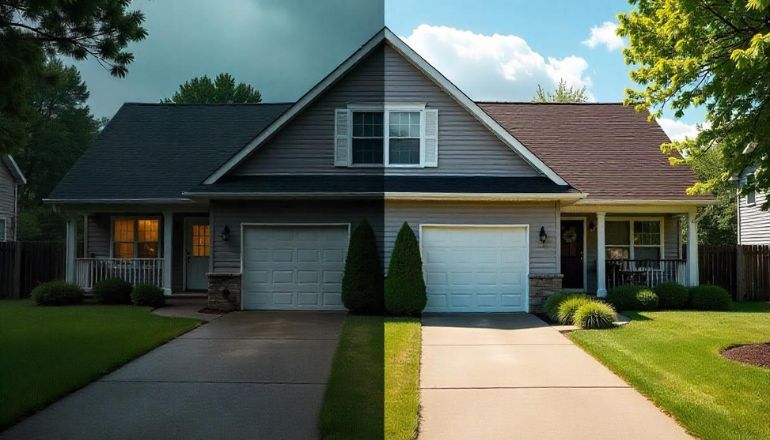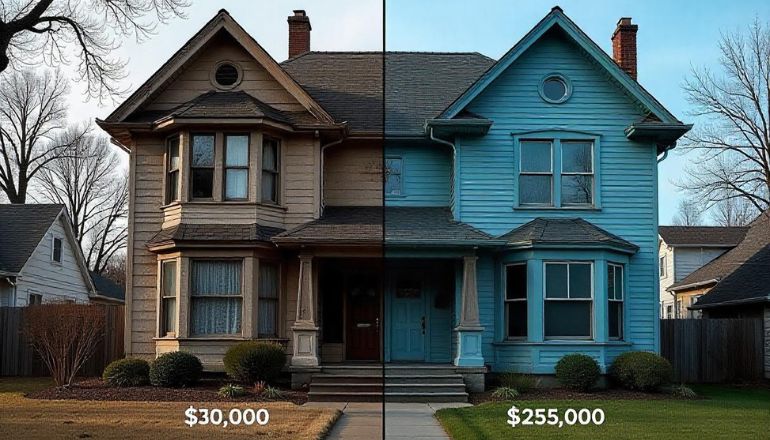How to Get ARV in Canada Real Estate

Calculating the After Repair Value (ARV) is a critical skill for real estate investors, especially in the Canadian market. Whether you’re flipping houses or simply looking to understand a property’s potential, knowing how to get ARV in Canada real estate can make or break your investment. Accurate ARV calculations help you assess the true value of a property after renovations, allowing you to make informed decisions about purchase prices, renovation budgets, and expected returns. In this guide, we’ll walk you through everything you need to know to master ARV estimation in Canada, giving you the tools to maximize your investment potential.
What Is ARV in Real Estate?
When investing in real estate, understanding ARV (After Repair Value) is crucial. It helps determine the potential value of a property after renovations, guiding investors on whether a property is worth buying or not.
ARV Meaning and Why It Matters
ARV refers to the estimated value of a property after improvements or repairs are made. It’s an important figure for investors to assess the profitability of a property flip or renovation project. ARV is determined by comparing the property’s value after repairs to similar, recently sold properties in the area (often known as comparables or “comps”). By accurately calculating ARV, investors can make more informed decisions about purchasing, renovating, and selling properties for profit.
ARV in the Canadian Market Context
Understanding ARV real estate Canada requires recognizing the unique dynamics of the Canadian property market. While ARV calculations follow similar principles worldwide, there are specific factors in Canada that can influence how ARV is determined, from local regulations to market trends.
Unique Challenges and Rules in Canada
In Canada, several factors make calculating ARV more complex. Local zoning laws, building codes, and municipal regulations can affect the extent of potential renovations and, consequently, the final value of a property. Additionally, regional market fluctuations such as differences in property prices between cities like Toronto and Vancouver can impact how ARV is estimated. Understanding these regional nuances and navigating Canada’s rules and regulations are essential to accurately forecasting a property’s after-repair value.
How to Calculate ARV Step by Step
Calculating ARV is a critical skill for any real estate investor. Knowing how to properly estimate the After Repair Value (ARV) can help you make smarter decisions when purchasing properties. Here’s a step-by-step guide to the process.
After Repair Value Formula Explained
To calculate ARV, you need to follow this general formula:
ARV = Comparable Sales (Comps) + Estimated Repairs/Improvements
- Find Comps: Search for recently sold properties in the same area with similar features (bedrooms, bathrooms, square footage, etc.) that are in similar condition to what your property will be after repairs.
- Evaluate Repair Costs: Estimate the total cost of repairs or renovations needed to bring the property up to the same level as the comparables.
- Apply the Formula: Add the value of the repairs to the price of comparable homes to arrive at your ARV estimate.
Real Examples from Canadian Listings
For instance, imagine you’re looking at a fixer-upper in a popular neighborhood in Vancouver. You find three comparable properties that recently sold for $600,000, $625,000, and $610,000. After calculating renovation costs (e.g., $50,000), you add that to the average of the comps ($611,667), which gives you an ARV of approximately $661,667.
This process will give you a realistic estimate of the potential selling price of the property after repairs and will help you determine if the investment is worth pursuing.
Tools and Methods to Estimate Renovation Costs
Accurately estimating renovation costs is crucial when calculating ARV. By understanding the costs of repairs and improvements, you can better assess the potential profitability of your investment. Here are some tools and methods to help you estimate these costs effectively.
Using Contractor Quotes and Local Benchmarks
One of the most reliable methods for estimating renovation costs is to get quotes from contractors. Contractors can give you a detailed estimate based on the work needed, providing a more accurate understanding of potential expenses. You should get multiple quotes from reputable contractors to compare prices and understand the scope of the work.
In addition to contractor quotes, it’s also useful to look at local benchmarks for renovation costs. Many areas have standard pricing for common renovations (e.g., kitchen remodels, roofing repairs, or bathroom updates). Websites that specialize in cost estimates, like HomeAdvisor, can give you a ballpark figure for what to expect for specific renovations in your area.
By combining contractor quotes and local benchmarks, you can create a more precise budget for your renovation project, helping you arrive at a more accurate ARV estimate.
ARV vs. Current Market Value
When investing in real estate, it’s essential to understand the distinction between ARV (After Repair Value) and Current Market Value. Both values play a crucial role in decision-making, but they serve different purposes.
What’s the Difference?
- ARV (After Repair Value) refers to the estimated value of a property after renovations or repairs are completed. It’s an important metric for investors looking to determine the potential future value of a property once it has been fixed up to meet market standards.
- Current Market Value, on the other hand, represents the current value of the property as-is, based on its condition and comparable sales in the area. This figure doesn’t take into account any potential improvements or repairs, offering a snapshot of the property’s present worth.
The main difference between the two is that ARV is future-oriented, focusing on what a property could be worth after it’s renovated, while Current Market Value is focused on its present value in the market. Understanding both values is essential for assessing whether a property is a good investment, as the ARV helps you estimate post-repair profits, while the current market value tells you what you’re paying for upfront.
Using ARV for House Flipping in Canada
When house flipping in Canada, ARV (After Repair Value) plays a pivotal role in evaluating the potential success of a project. Investors use ARV to determine if a property is worth purchasing, the cost of renovations, and the final selling price once improvements are made. Here’s how ARV is crucial in the flipping process.
Financing, Risk Assessment, ROI Estimation
ARV helps investors secure financing by providing lenders with a clear estimate of the property’s potential after repairs. Lenders typically finance a percentage of the ARV, especially for renovations or house flipping projects. A higher ARV can help you obtain more favorable loan terms, reducing your upfront investment.
Evaluating ARV also helps in risk assessment. If the estimated ARV is significantly lower than expected, the property might not be worth the investment. It allows investors to identify potential risks like overpaying for a property or underestimating renovation costs.
By comparing the ARV to the cost of acquisition and renovation, investors can estimate their Return on Investment (ROI). The formula for ROI is:
ROI = (ARV – Total Investment Costs) / Total Investment Costs
This calculation helps determine the profitability of a house flip and informs decisions on whether the project is worth pursuing. Calculating ARV accurately ensures that the house flipping venture is financially viable and can lead to significant returns.
Mistakes to Avoid When Calculating ARV
Calculating ARV accurately is essential for successful real estate investing. Avoid these common mistakes to ensure your calculations are on track when figuring out How to Get ARV in Canada Real Estate:
- Ignoring Comparable Property Condition: Ensure the properties you compare are in similar condition. Don’t compare fixer-uppers with fully renovated homes.
- Overestimating Renovation Impact: Be realistic about the value renovations will add. Not all improvements bring equal returns.
- Relying on Outdated Comps: Use the most recent sales data to calculate ARV, as market conditions can change quickly.
- Underestimating Local Market Factors: Understand local trends and neighborhood dynamics, as they can significantly affect ARV.
- Neglecting Additional Costs: Include all costs like closing fees, taxes, and holding expenses to get an accurate estimate of potential profits.
By avoiding these mistakes, you can make more informed decisions and maximize your investment returns.
FAQ
What is the best way to calculate ARV in Canada?
The best way to calculate ARV in Canada is by analyzing recent comparable property sales (comps) in the same area, factoring in your renovation costs, and considering the current market conditions.
Is ARV used by Canadian lenders?
Yes, Canadian lenders use ARV to assess the potential value of a property after renovations, especially for financing house flipping projects.
How does ARV affect investment decisions?
ARV helps investors determine the potential profitability of a property by estimating its future value post-renovation, guiding decisions on purchase price, financing, and renovation budgets.















